X-RAY RUNS: Apply for Beamtime
2017 Nov 1 - Dec 21
2018 Feb 7 - Apr 3
2018 Proposal/BTR deadline: 12/1/17
2018 Apr 11 - Jun 4
2018 Proposal/BTR deadline: 2/1/18
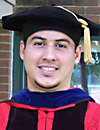
Contact: E. Fontes (ef11@cornell.edu)
“Fuel cells as energy sources” and “organic light-emitting diodes” are keen interests of one of Cornell’s newly-minted physical chemists, Daniel Blasini. His graduate work at Cornell won the second annual Ph. D. Thesis Prize by the Cornell High Energy Synchrotron Source (CHESS). His graduate thesis, “Characterization of thin films and thin film phenomena in electrochemically active systems via x-ray methods,” documented five years of work focused on detailed surface structure and function of materials used in the high technology world of fuel cells, batteries and displays. During this time, Daniel developed methods and instruments to probe the physical chemistry of newly synthesized materials using powerful synchrotron x-ray beams.
The prize was given at the 2007 CHESS Users’ Meeting held June 12th and 13th in Ithaca, New York. Completed in June 2006, Blasini’s thesis study was supervised by Professor Hector Abruña, chair of the Department of Chemistry and Chemical Biology and co-director of the Cornell Fuel Cell Institute. The CHESS Users’ Meeting was held at the Robert Purcell Community Center, where Blasini was awarded a $1000 honorarium and gave the invited student lecture to a meeting audience of over 150 scientists and students.
The prizewinner was chosen from among candidates recommended by their advisors and whose thesis work involved substantial use of x-ray data collected at the CHESS facility. The prize selection committee included a mix of faculty from inside and outside Cornell as well as a single CHESS facility representative. In his recommendation letter to the prize committee, Abruña noted, “whereas Daniel is clearly an accomplished researcher, an equally important aspect is that he brought new techniques and methodologies (and revived some old ones!) to my laboratories so that x-ray based techniques are now an integral part of our experimental repertoire. Such contributions and abilities are rare and speak volumes as to Daniel’s talent and initiative.”
Daniel was among the first Cornell graduate students to begin the tradition of synchrotron education at the “G-line” facility. “G-line” is the latest beamline facility, added to CHESS in 2000, whose goal was to educate graduate students in the intricacies of synchrotron x-ray instruments by involving them in the design, construction and on-going support and maintenance of a synchrotron beamline. “While it is true that graduate students can visit any of a handful of synchrotron x-ray sources in the United States (or abroad), at almost none of those established facilities can students work inside the shielding walls,” says Sol M. Gruner, director of CHESS and faculty in the Physics Department at Cornell. “By helping to design and build the beamline front-ends, x-ray optics, station hardware and software for data collection and analysis, CHESS is training scientists who will go out and build future instruments that advance their fields of science wherever they go.”
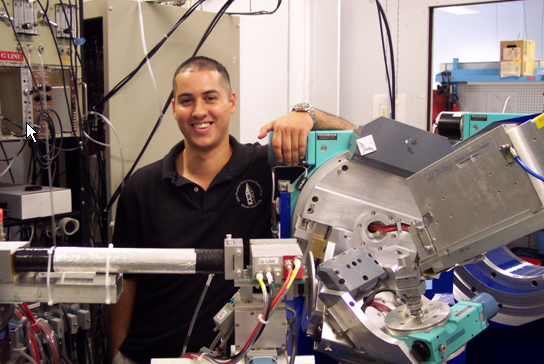
Daniel Blasini with the
grazing-incidence x-ray diffractometer inside the
CHESS G2 experimental station.
Daniel’s presentation began with a lighthearted look over his five years at Cornell. He remarked that his experimental hutch at CHESS, the G2 station, was empty at the start of his education and was packed full when he left. He expressed great thanks to all the people who helped in his work; faculty, scientists, technicians and machinists who all added to his knowledge of “how to get things done.” He showed pictures of a “young station” full of improvised equipment – all borrowed and held together loosely with c-clamps and tape. Before the x-ray optics were fully commissioned the beam intensity was quite low. That didn’t deter a desperate student, though, and he learned a great deal about x-ray science (and practicality) by seeking out specimens that provided useful data with low signals. “No photons were wasted,” he boasted.
In early work Daniel led the Abruña group in studies on how dimensionality affected chemical activity and physical structures, starting with Dend-8-tpy/Co2+ multilayers (see sample references at end). After that, the station started developing rapidly. The summer of 2003 saw the optics room completed and commissioned. Daniel’s “conscripted service” included motorizing the x-ray front-end, optics and in-vacuum equipment. Inside the G2 station, Daniel worked closely with fellow graduate student David Nowak (Baker group in Materials Science and Engineering) and CHESS staff scientist Detlef Smilgies to build a kappa diffractometer and beamline for grazing incidence x-ray diffraction (GID). GID is especially sensitive to chemistry and chemical ordering at the surfaces of materials. Later he collaborated with fellow graduate student Yi Liu (Abruña group) to commission an in-situ electrochemical specimen cell for the G2 station. Because high-energy x-ray beams can penetrate liquid layers of the cell, in-situ x-ray measurements are one of the few ways scientists can gather structural information on active, functioning chemical catalysts in working fuel cells.
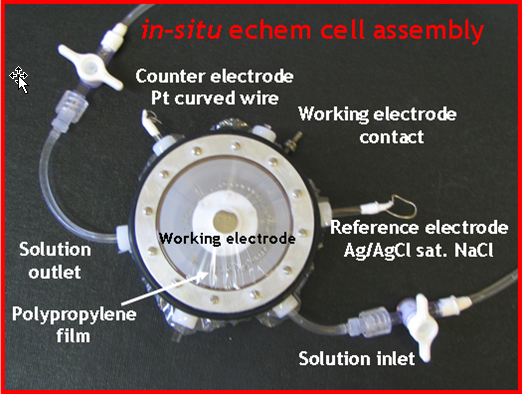
Photo of the
electrochemical cell used to collect in-situ x-ray diffraction data from an electrode surface (disk
at center) while immersed in solution contained by the
polypropylene film.
From the many different systems they studied, Blasini choose to speak of his work with organic light-emitting diodes (OLEDs). OLEDs produce light as they pass electric current. Ruthenium-based complexes were straightforward to prepare and as ionic transition metal complexes they were useful candidates for technological devices because of rapid turn-on, efficiency and color emission. He studied a model electrochemical device with Ru(bpy)3+n complexed with gold deposited on an indium-tin oxide film and showed how morphology affects light-producing efficiency. GID was used to limit the penetration depth of the x-ray beam while collecting data with high signal-to-noise from films as thin as 1000 angstroms. Their lab had synthesized a number of ruthenium complexes that were known to have different light-emitting efficiency. They had no knowledge of the crystal structures of these specimens nor was it known what role, if any, structural differences might play in controlling observed efficiencies. Despite expectations of finding amorphous structures, in fact they measured short- to medium-range order at about 3-5 nanometers. Larger distances between Ru atoms showed increased efficiencies, perhaps because of longer scattering lengths or fewer defects.
The effects of humidity were also fascinating; they found that water absorbed by thin films caused crystallization and dramatically reduced electron mobility. They deduced that both chemical and structural changes must be taking place, and were soundly convinced of the importance of being able to perform in-situ x-ray measurements coupled to Raman and other techniques. The report of this work was highlighted on the cover of the April 2007 edition of Journal of Materials Chemistry (reference below).
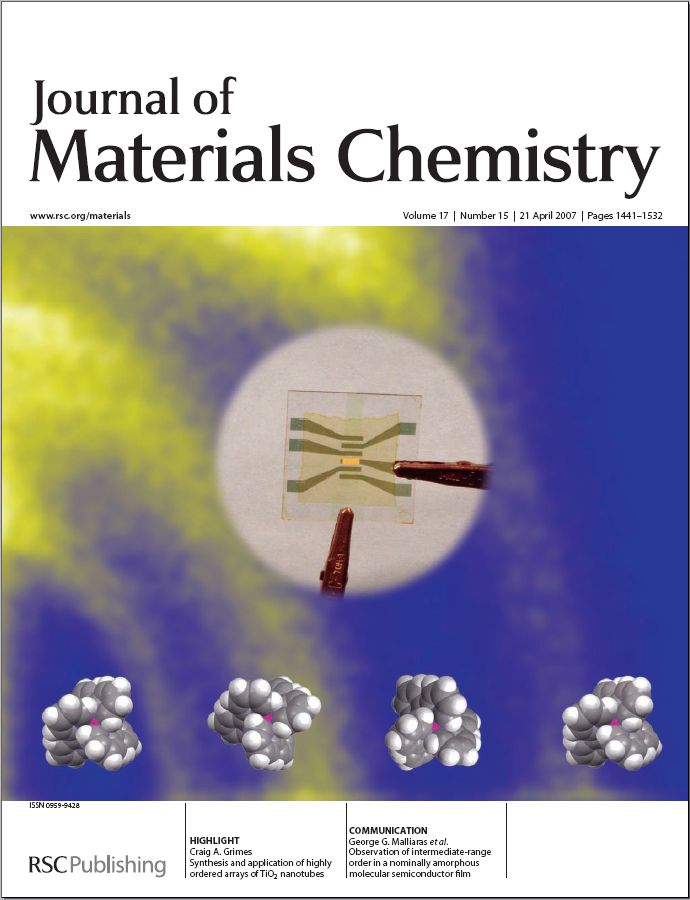
Blasini et al. work published recently and highlighted in Journal of
Materials Chemistry (2007;17 (15):1458-61).
When asked how work at CHESS differed from previous experiences, Daniel recalls his prior history working in electrochemistry labs where all the instrumentation was commercially available. “We didn’t have to worry about data acquisition schemes or any instrument designing or machining.” He was quick to adopt a different mentality, learning to work with the scientific and technical staff at CHESS to design and build his own equipment and stay on the job until the x-ray instruments fully worked. He adds: “When someone asks me about G-line the first things that jumps into my head are cable making and motor testing. …it is amazing that something as simple as troubleshooting motors taught me a lot about how to approach and solve problems. I think in general all the logic behind the preparation, the performing, and the data analysis of the experiments that I performed at G2 made me a better problem solver.”
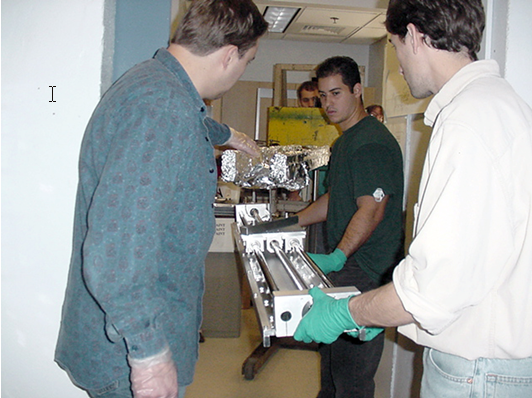
Blasini (center)
helps the CHESS technical crew install a 2-meter long
in-vacuum optics translation stage. Tom Krawczyk
is left, Chris Conolly right, and Dana Richter
controlling the hand lift in rear.
Blasini did his undergraduate studies in chemistry at the University of Puerto Rico (UPR), Rio Piedras, the same city where he was born and raised. While at UPR, Daniel received a NIH-MARC (Minority Accesses to Research Careers) Undergraduate Research Fellowship and worked as an analytical chemist research assistant under the supervision of Dr. Carlos R. Cabrera. In Cabrera’s group he was first introduced to work on alternate forms of energy, particularly characterizing the surface of modified electrodes for various applications. In the summer of 1998 he participated in the NSF-REU (Research Experience for Undergraduates) program at Harvard University under Dr. Eric Mazur. There he designed and built an autocorrelator to measure femtosecond laser pulses, and was first introduced to motion control systems, machining, and the art of designing and building scientific instrumentation.
During the spring of 1997 he was granted the ACS Undergraduate Award in analytical chemistry. He earned the Undergraduate Excellence Award from the College of Chemists of Puerto Rico in both 1997 and 1998. He earned his Bachelor of Science degree in Chemistry on January 1999, that same year he joined the chemistry graduate program at UPR. A year and a half later he decided to join the Cornell graduate program in Chemistry and took on the challenge to build the x-ray instruments at CHESS. During his time at Cornell he also participated in activities to encourage the interest in science of Latino children and participated in numerous outreach activities throughout the Cornell Center for Materials Research.
Blasini has relocated to Johns Manville in Littleton, CO, where he is part of the group doing surface characterization analysis (AFM & XPS) of polymer binders on glass fibers for insulation applications. Abruña’s group is continuing to use CHESS to further understand surface oxide structures and dynamic processes that produce the active catalytic surfaces. In-situ x-ray studies of functioning fuel cells are in the not-too-distant future.
See attached PDF of latest article: (pdf)
Recent publications:
Blasini DR, Rivnay J, Smilgies DM, Slinker JD, Flores-Torres S, Abruna HD, Malliaras GG. Observation of intermediate-range order in a nominally amorphous molecular semiconductor film. Journal of Materials Chemistry 2007;17 (15):1458-61.
Nowak DE, Blasini DR, Vodnick AM, Blank B, Tate MW, Deyhim A, Smilgies DM, Abruna H, Gruner SM, Baker SP. Six-circle diffractometer with atmosphere- and temperature-controlled sample stage and area and line detectors for use in the G2 experimental station at CHESS. Review of Scientific Instruments 2006;77 (11).
Blasini DR, Rochefort D, Fachini E, Alden LR, DiSalvo FJ, Cabrera CR, Abruna HD. Surface composition of ordered intermetallic compounds PtBi and PtPb. Surface Science 2006;600 (13):2670-80.
Blasini DR, Flores-Torres S, Smilgies DM, Abruna HD. Stepwise self-assembly of ordered supramolecular assemblies based on coordination chemistry. Langmuir 2006; 22 (5):2082-9.
Smilgies, D.M.; Blasini, D.R.; Hotta S.; Yanagi H. J. Synchrotron Rad. 2005, 12, 807.
Volpe, D.; Casado-Rivera, E.; Alden, L.; Lind, C.; Hagerdon, K.; Downie, C.; Korzeniewski, C.; DiSalvo, F. J.; Abruna, H. D. Journal of the Electrochemical Society 2004, 151, A971.
